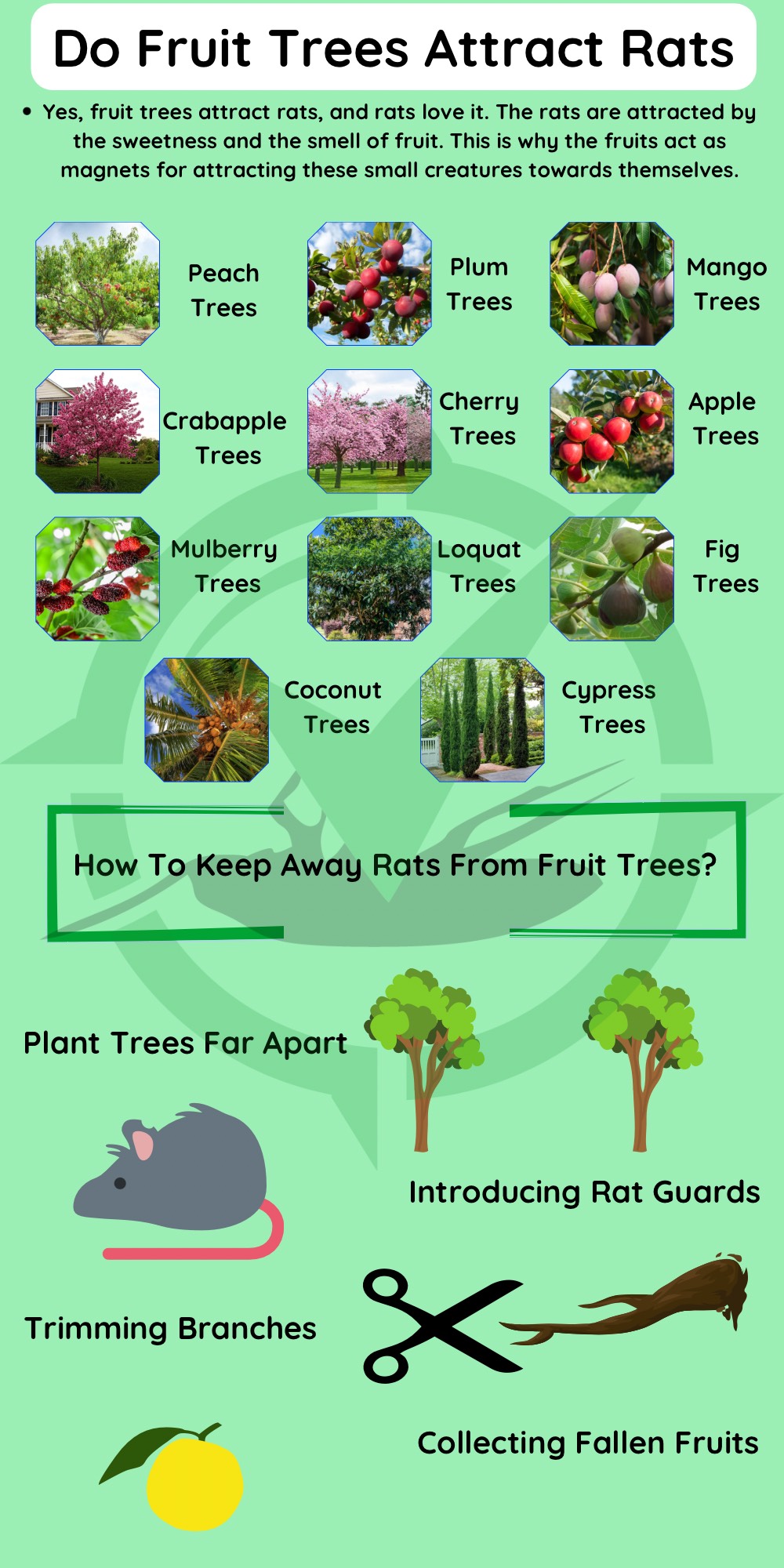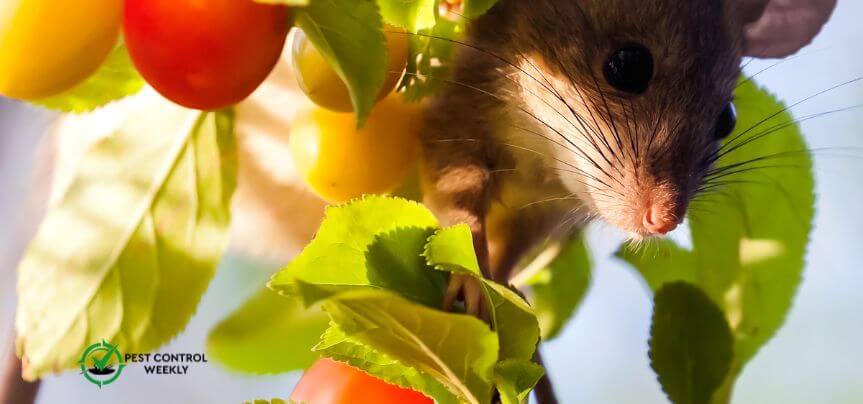It is a fact that rodents like rats can eat anything. Whether it is plants or meat, they will have it to fulfill their appetite. Rats are attracted by a variety of food but do fruit trees attract rats?
Yes, fruit trees attract rats, and rats love it. The rats are attracted by the sweetness and the smell of fruit. This is why the fruits act as magnets for attracting these small creatures towards themselves.
In this article, you will read about what kinds of fruit trees attract rats and why they prefer them. We will also look at methods of keeping fruit trees safe and protected from rats.

Do Peach Trees Attract Rats?
People who have studied the diet pattern of rats believe that rats are mainly attracted to citrus trees. However, rats are also driven toward common trees and bushes.
They can be very enticing for the rats, who come out at night to feed on them. These include peach trees, figs, and bushes with nuts, like walnuts and almonds.
A rat will only eat the external surface of the peach and will out the seed as it is hard for the rat to consume it. Rats love peaches, and only they find one; they eat more than one at a time.
Do Plum Trees Attract Rats?
Rats love giving themselves sugary treats. That is why they are always on the lookout for sweet fruits. That is one of the reasons why rats prefer having berries in fruits.
Berries are pretty famous for consumption among rats. Feeding on berries can make a rat’s stool appear red and resemble blood. So, you should be aware of that.
There are many other fruits on which the rats feed. This includes watermelons, kiwis, pears, grapes, peaches, and cantaloupes. A rat would prefer finding fruits for itself, whether from trees, bushes, or even trash cans.
Do Mango Trees Attract Rats?
It is not only humans who are mango lovers. The rats are no less! A rat will climb the tree trunks to reach out for the mangoes and consume them.
Rats’ teeth are sharp enough to penetrate a mango’s peel. A rat enjoys sucking on the mango juice and having it for a long time. However, there are ways you can protect your mangoes from rats.
One thing you can do is wrap the tree trunks with plastic sheets or metal sheets. This prevents the rats from climbing up as they will not have a proper footing on wood.
Do Crabapple Trees Attract Rats?
Crabapple trees are not only a natural but also a significant winter food source for rats. Rats are fond of crabapples. It has been observed that leaving crabapple fruit on the ground attracts rats.
The rats even go as far as eating away the bark of crabapple trees, damaging them. Not only this, but they also feed on buds, flowers, and leaves. As a result, the nectar is reduced, and pollen availability reduces. This can lead to a decline in plant’ production and death.
You can put mulch around the lower back area of the tree, or you can wrap the trunk with a cloth. This is effective in keeping the rats away from crabapple trees.
Do Cherry Trees Attract Rats?
Yes, the cherry trees attract rats toward themselves. Rats like to eat cherries often. However, rats do not make up a majority of their diet. This is because rats do not have the best digestive system for fruits.
This upsets their stomach. Moreover, cherries have high sugar content, and rats do not need that much sugar daily. The wild rats prefer to feed on fruits as they are a direct energy source.
The downside of sugary fruits is that rats can develop obesity and tooth decay. A lot of other issues can also occur.
Do Apple Trees Attract Rats?
Having fruit trees in your garden or farm is an excellent way for having your production sustain itself. While trying to benefit from your orchards, they also act as an open invitation for pests and rodents.
Rats are unwanted pests that will travel miles to reach apple trees and consume them. It is usually the fallen apples that the rats take away to their hideouts.
Such juicy and sugary fruits act as magnets for rats, and they cannot resist them. A rat will eat away from the entire fruit, leaving the seeds for dispersal.
Do Mulberry Trees Attract Rats?
Mulberry is a type of berry that has a high vitamin C content. It also has antioxidants, which are excellent for an organism’s well-being and health.
Rats can consume mulberries in two forms; either they can have it in their raw state or in the cooked form. The wild rats obtain them from the forest trees. On the other hand, domestic rats creep up in the kitchen and search for the cooked ones.
It can be read from the paragraphs above how much the rats love berries and will do anything to have them! Alongside berries, a rat will consume its leaves too.
Do Loquat Trees Attract Rats?
As loquats are produced in large numbers up on the trees, they can attract a whole population of rats at the site. Those who own the land have a huge problem to take care of.
The rats are nocturnal animals and will come out at night to feed on fallen loquats. Moreover, they will also go as far as climbing the trees to obtain and store a few loquats for themselves.
Do Fig Trees Attract Rats?
b Yes, indeed, the fig trees attract rats towards themselves. The rats roam the earth’s surface at night to claim anything edible.
The rats are also fond of eating avocados, lemons, oranges, and peaches. All the nuts that fall should immediately be collected or cleared away; otherwise, the rats will come and get them during nightfall.
Do Coconut Trees Attract Rats?
The rats have potent teeth that are sharp enough to reach the hide of coconut and feed on the juice inside. A rat excavates through coconut hairs and inside the fruit from the top.
Some species of rats are capable of living inside tree canopies, where they can feast on nuts and fruits. Although the coconuts still do not attract a large population towards themselves, a rat can feed on one whenever it finds it.
Do Cypress Trees Attract Rats?
There is a whole list of trees that attract rats. These include juniper bushes, palm trees, ivy plants, and cypress trees. With their dense vegetation, they form perfect homes for rats.
A rat always looks for a hide-out that offers dense shade and protection to them. A rat does not want to be found or discovered during the day by its predators. That is why they chose their hide-outs specifically. The rats use cypress trees to inhabit them.
How To Keep Away Rats From Fruit Trees?
There are several ways by which you can keep rats away from fruit trees. Implementing these ways will save your trees from rat attacks.
Plant Trees Far Apart
If tree branches are intertwined, the rats can easily climb and run from one tree to the other. Also, if the trees are closer to residential areas, it will make it easy for the rats to jump over your rooftops and enter your home.
That is why care must be taken while planting trees. They should be kept far apart. This will limit the access of rats.
Introducing Rat Guards
Wrapping a simple plastic sheet or a metal sheet can prevent rats from climbing tree tops. You have to wrap this sheet around the bark of the tree. This prevents a rat’s grip on the tree, making it difficult to climb up and eat fruits.
Trimming Branches
The droopy branches must be cut off. The bent branches are usually the ones to which rats cling and climb upwards. Such branches are also the ones from which fruits fall off the most.
That is why they must be pruned. It will keep the rodents away from trees and your fruits safe from falling into the hands of pests.
Collecting Fallen Fruits
If you own an orchard or farm, care must be taken to pick up the fruits timely. It would be best if you kept an open eye for the seasonal fruits, their time of ripening, and be vigilant enough to pick the fruits when they fall off.
Fallen fruits also include the ones we throw away in the trash in plastic wraps. It would help if you sealed them properly so that it does not invite rats into a trash can to spill over and make a mess in your garden.
Conclusion
Rats are powerfully attracted to fruit trees and eat them as part of their diet. Keeping the rats away from berries and other sugary fruits is hard.
However, you must protect trees or lessen the frequency of rat attacks by taking up any of the measures that have been mentioned above.

